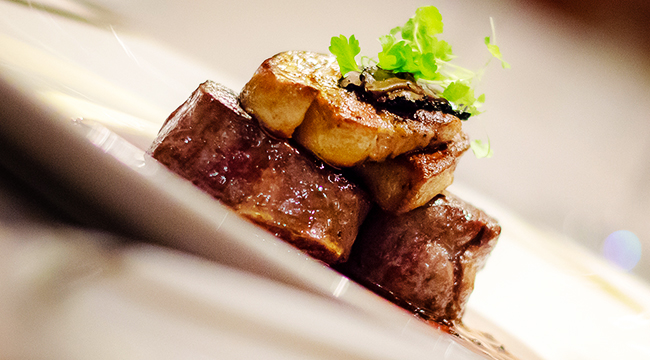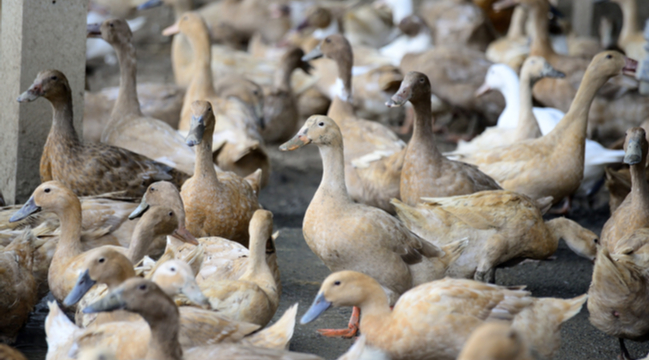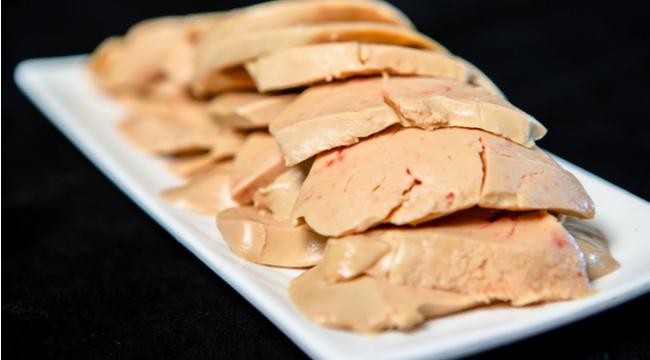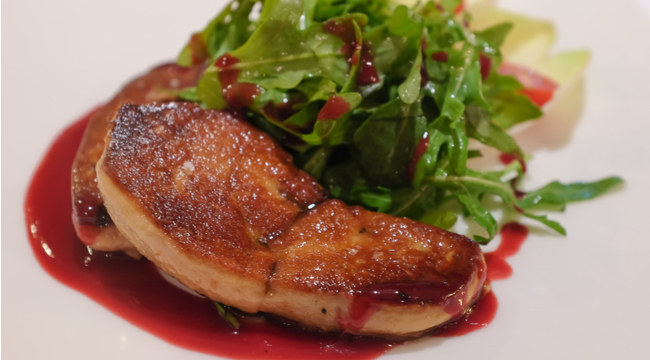
Foie Gras is the most controversial ingredient in the American food scene — a sentence that reads just a little bit crazy in a country that has embraced the horrors of factory farming. Last week, California re-banned the sale of foie gras. The delicacy was originally banned in the state back in 2004, a move which was later overturned for being “constitutionally vague” in 2015. now, the Ninth Circuit Court of Appeals in California has ruled that the ban can be reinstated. PETA and the Humane Society have begun “popping the champagne” in celebration, while chefs and food lovers bemoan the step backward.
The issue at the center of this conflict is a practice called “gavage” in which geese and ducks are fed with tubes that extend down their throats. It’s not particularly pretty — in idea or practice — but that’s not to say that it’s fully monstrous either. Compared to clandestine chicken farm videos, it seems downright kind. In truth, your reaction to gavage offers a window into what level of dominion you feel humans deserve over animals. If you believe we have the right to harvest animals in general, it’s doubtful that you’ll have a particular problem with foie gras, in specific. Not when our chicken practices seem to be so much more cruel.
Let’s take a moment and look at the science and reality of what foie gras is and how it’s made. What we aim to do here is provide you with the science and facts so that you can decide whether or not the foie gras produced in the United States is something you want to eat.
WHAT IS FOIE GRAS?

Foie gras is fattened duck or goose liver. It’s buttery, luscious, nutty, and — if you’re a meat eater — almost unarguably delicious. Seared or turned into a pâté or torchon, foie gras is the mountaintop of many a gourmand’s paths to food glory. Yet this one morsel of food is highly contentious. Animal welfare groups have been fighting the production of foie for decades by claiming the gavage process cause the livers to become “diseased.” The word is quoted for a reason — it’s heavily debated.
The practice of the gavage is much older than French cuisine. It reaches as far back at 4,500 years ago, when ancient Egyptians used gavage to fatten up their ducks for their menus (there are hieroglyphics of this). So this is a very, very old practice that has survived eons of human development. It’s a practice that was perfected several millennia ago mostly because it works. But, we get it, shoving a tube down a bird’s throat still sounds and looks deplorable, even carved in ancient Egyptian stone.
HOW FOIE GRAS IS PRODUCED

Foie gras is made from one duck breed in the US — a hybrid of a Muscovy and Pekin called a Moulard. Their bodies are straight up made for gorging, because Pekins are migratory and Muscovy are big, tough birds that aren’t migratory. So the out-sized anatomy of the Muscovy combined with the gorging ability of the Pekin makes the Moulard the perfect duck for the gavage process.
Understanding how ducks (and geese) gorge themselves is paramount to understanding foie gras. Migratory birds like Pekins and most geese spend the fall months throwing down as much food as possible to build up stores of fat to migrate south for the winter — they also do this on the northern migrations. So, these animals are pre-disposed to a gorging diet. This is replicated on farms where it takes over three months to raise the birds, with the last 12-22 days being devoted to the gavage.
The biggest aversion humans seem to have to the gavage and gorging is the feeding tubes. To a human with a single entry point for our esophagus (where food goes) and our trachea (where the air goes) having a tube shoved down our throats is untenable. But, the feeding tube used for the gavage doesn’t cause a gag reflex in ducks because duck anatomy isn’t like ours.
Ducks have separate tubes for their esophagus and trachea. Ducks breathe through their tongue. They also have no teeth so they swallow their food whole. And they can swallow entire live fish — one after another. They store whole food in their necks (a place called the crop) and then they swallow pebbles into their gizzards to grind the food over the course of the day. So, suffocation does not happen during the gavage, nor does it while ducks are eating normally. Ducks are used to swallowing food whole (and live) and their air pipes are never impeded.
What exactly is being forced into the crops of these ducks? The feed is usually a corn mashed with fats to accelerate the fattening process. The gavage tube is the exact length to deposit the feed into the duck crop, so that the gizzard can do its work. These gizzards can hold up to 950 grams when expanded and their feeds via gavage are (on average) 450 grams, three times a day. On the three foie farms in the United States, feeders will not feed ducks if they still have food in their crop, so as not to overfill the duck’s crop.
All of this means that the ducks can withstand fattening up, because their bodies are built for exactly that. Their anatomy is literally engineered to gorge. Furthermore, the three farms that produce ducks for foie gras production are largely free range and heavily regulated at all times by USDA observers. Compare that to egg-laying chickens living in cages so small they cannot move and have their beaks removed en masse — it’s incomparable. This is a parallell point, obviously, and isn’t a proof that gavage is okay, but it’s odd that one is so scrutinized while the other is millions of times larger in scale and still largely ignored. Ducks from the foie gras farms are used in their entirety and largely live a pretty easy exitance for their three months of life, when compared to the ten weeks of horror chickens live through just for eggs before being disposed of.
WHY IT’S A BATTLEGROUND

A lot of the controversy around foie gras stems from poor farming practices in other countries around the world. And indeed, bad farming practices do take place. There’s no one denying that. But, if you’re in the United States, you’re going to be getting foie gras from one of only three farms around the country. All of which have extremely high standards and are highly regulated for animal welfare. Add in the misconceptions of duck anatomy and you have a misinformed public willing to believe the worst. It’s not hard to believe. The image of a duck or goose with a feeding tube down its neck is hard to see. That makes gavage a very easy target.
It’s worth noting that the American Veterinary Medical Association didn’t take a negative stance on foie gras after a full, 89-page review. This is because they’re vets and understand the anatomy of the birds better than a protester who’s relying on an emotional response to a photo. The AVMA concluded, “Scientific information is available dealing with the animal welfare concerns associated with foie gras production, but the observations and practical experience shared by HOD members indicate a minimum of adverse effects on the birds involved.” They found that because of what ducks are and how they operate, the gavage and foie gras production is not a bad practice when it comes to farming waterfowl — particularly in the United States, where hefty regulation protects the animals.
Still, animal rights groups like PETA and the Humane Society remain extremely vocal critics of foie gras. They’re using the word “diseased” to describe the fatten livers. This word is contentious, since — scientifically speaking — diseases are caused by external pathology or internal dysfunctions of the immune system. This is not the case with ducks on American farms producing foie gras. Instead, truly diseased ducks are culled immediately to protect the flock. PETA has won some highly important fights in their time, but have also made hotly debated suggestions that bovine milk causes autism, and have been accused (in a variety of situations) of dismissing scientific thought in favor of emotional grandstanding.
There’s more than just emotions at play here. Farms that produce foie gras are often sued by animal welfare groups. Legal fees for farms like Hudson Valley can reportedly cost up to $50,000 a month. Yet, farms like Hudson Valley have been able to survive without decreasing the high standards of their duck farm practices in light of these litigations. Furthermore, as Temple Grandin wrote “When farming practices are made illegal or stopped entirely in a country, the practices move underground or overseas, where the standards are far worse and animals suffer far more.”
So, is it ethical to eat foie gras? If you think it’s ethical to eat non-factory farmed animal protein, then probably. Foie gras is produced by small-time farmers who, across the board in America, have the highest of standards and practices for their animals. And when compared to the mass-produced nightmare that is factory farmed meat, foie gras looks idyllic.
The biggest obstacle is to not anthropomorphize ducks and understand the anatomy and science behind the farming practices of the gavage. Then, if you still don’t like foie gras — either because of how it’s produced or for its taste — you’re all good. At least you’ll have your facts straight.






